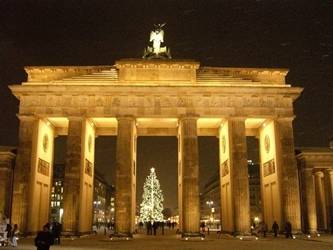The Berlin trip is one of the few at Oundle that is run because of sheer necessity. It is difficult to do anything more than blunder through the modern world without an awareness of the recent past. However, whether it was this or the near-mythic status that the trip has acquired over the years that led to eighty or so Oundelians setting off for the German capital, I cannot say. The Berlin trip provides a harsh physicality to studying the Holocaust and the Cold War, that a comfortable, well-heated classroom can hardly convey. This was evident from the onset, as the city’s hulking industry made itself felt in towering construction sites and concrete Bauhaus buildings. However, this was only one side of the city, and though much of modern Berlin follows in the utilitarian mould of soviet-occupied East Germany, an older Prussian world was still tangible behind it.
On foot and on the efficient public transport, we visited a combination of tourist and off-the-beaten-track sites, each with its own ambience. The mist-enveloped Tiergarten of the first morning had a ghostly element to it, evoking its WWII obliteration. The trip to the Reichstag found us overlooking the city’s majestic night skyline, finally understanding how all the places we had visited during the day fitted together to make Berlin. In fact, many of the trip’s more dramatic moments took place in the half-light: walking between the giant tomb shapes of the Jewish memorial, looking over the ‘bridge of spies’, a view seen by many prisoners returning to the East or West in the Cold War. Visiting sites of resistance to the Nazis, or rather where it was brutally crushed, did something to help our dwindling faith in humanity. Walls covered in the faces of those who had stood up to Hitler, beside stories of how they and those they knew were tortured and killed, formulated a question about standing up to dictatorship. The glorious, heroic idea that we would never have let the Nazis do what they did had we been there, slowly faded. We had just an inkling about life under terror (this time the Soviets) when we visited the Stasi museum. For most of us, this was enough for our self-preservation instincts to kick in.
The acknowledged climax of the trip was the visit (for want of a better word) to Sachsenhausen, the Nazi, and later Soviet, concentration camp. After spending our lunchtimes in the busy Christmas markets, this was certainly a sobering experience. As we went through the camp, people slowly began to fall silent. It was the smaller details that made the difference: being told about the human skin lampshades, the bedding of human hair, seeing the crude but powerful graffiti. Not infrequently, pity turned to nausea and some felt their ability to dwell on ‘man’s inhumanity to man’ a little tested. Certainly, it was grim history and felt rather like the intellectual equivalent of taking medicine, but, to return to my beginning, it was necessary. There was a recurring comment: ‘I don’t understand.’ We were faced with the seemingly incomprehensible. Either way, understanding or bewilderment, there was the sense of looking into the void.
That, however, was not what I took away from the Berlin trip. Behind every reminder of terror and mortality, there was an insistence that we should enjoy every moment of our lives. It was more a lesson in appreciation than lamentation. Although the time on the clock tower over Sachsenhausen has been stopped, showing that the era is over, the Berlin trip was a reminder of just how quickly our own time is slipping away.
Isabella Wythe (W)






